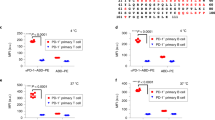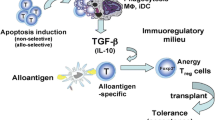Abstract
Immune privilege is a unique strategy developed in several internal organs that can prevent the development of immune attack against these vital organs. One critical mechanism of immune privilege is utilizati of Fas/FasL-mediated apoptosis to delete the invading T cells at the immune privilege sites. In this article, we describe the development and application of a unique cell-gene therapy to correct defective FasL-mediated apoptosis and autoimmune disease in autoimmune mice. This cell-gene therapy strategy using antigen-presenting cells (APCs) to express FasL is not only a therapeutic tool, but also has allowed us to understand the complexity of T cell regulation and the concept of eliminating T cells in the spleen, lymph node, orelse where in vivo to regulate the homeostasis of the peripheral T cell response. In this regard, the FasL-expressing APCs can be considered as circulating and regulatable immune privilege sites. Our studies provide substantial evidence that FasL-expressing APCs can be introduced exogenously without liver toxicity to eliminate infiltrating T cells and prevent the development of immune attack in lung, liver, kidney, joint, and salivary gland. Therefore, given the hazardous potential of persistent T cell invasion at the local inflammatory site, it is tempting to speculate that such an endogenous control mechanism occurs normally in vivo to limit a chronic T cell inflammatory response.
Similar content being viewed by others
References
Quallet J, Baumann N, Marie Y, Villarroya H. Fas system upregulation in experimental autoimmune encephalomyelitis. J Neurol Sci 1999;170:96–104.
Garcia-Velasco JA, Arici A, Zreik T, Naftolin F, Mor G. Macrophage derived growth factors modulate Fas ligand expressions in cultured endometrial stromal cells: a role in endometriosis. Mol Hum Reprod 1999;5:642–650.
Watanabe-Fukunaga R, Brannan CI, Copeland NG, Jenkins NA, Nagata S: Lymphoproliferation disorder in mice explained by defects in Fas antigen that mediates apoptosis. Nature 1992;356:314–317.
Wu J, Zhou T, He J, Mountz JD: Autoimmune disease in mice due to integration of an endogenous retrovirus in an a proptosis gene. J Exp Med 1993;178:461–468.
Takahashi T, Tanaka M, Brannan CI, Jenkins NA, Copeland NG, Suda T, Nagata S. Generalized lymphoproliferative disease in mice caused by a point mutation in the Fas ligand. Cell 1994;76:969–976.
Steinberg AD, Raveche ES, Laskin CA, Smith HR, Santoro T, Miller ML, Plotz PH: NIH conference: systemic lupus erythematosus: insights from animal models. Ann Intern Med 1984;100:714–727.
Cohen PL, Eisenberg RA: The lpr and gld genes in systemic autoimmunity: life and death in the Faslane. Immunol Today 1992;13:427–428.
Matsumura R, Umemiya K, Kagami M, Tomioka H, Tanabe E, Sugiyama T, Sueishi M, Nakajima A, Azuma M, Okumura K, Sumida T: Grandular and extraglandular expression of the Fas-Fas ligand and a poptosis in patients with Sjögren's syndrome. Clin Exp Rheumatol 1998;16:561–568.
Ohlsson M, Skarstein K, Bolstad AI, Johannessen AC, Johnnson R: Fas-induced a poptosis is a rare event in Sjögren's syndrome. Lab Invest 2001;81:95–105.
Jabs DA, Lee B, Whittum-Hudson J, Prendergast RA: The role of Fas-Fas ligand-mediated apoptosis in autoimmune lacrimal gland disease in MRL/MpJ mice. Invest Ophthalmol Vis Sci 2001;42:399–401.
Wahlsten JL, Gitchell HL, Chan CC, Wiggert B, Caspi RR: Fas and Fas ligand expressed on cells of the immune system, not on the target tissue, control induction of experimental autoimmune uveitis. J Immunol 2000;165:5480–5486.
Bamberger AM, Schulte HM, Thumeke I, Erdmann I, Bamberger CM, Asa SL: Expression of the apoptosis-inducing Fas ligand (FasL) in human first and third trimester placenta and choriocarcinoma cells. J Clin Endocrinol Metab 1997;82:3173–3175.
Bellgrau D, Gold D, Selawry H, Moore J, Franzusoff A, Duke RC: A role for CD95 ligand in preventing graft rejection. Nature 1995;377:630–632.
Griffith TS, Brunner T, Fletcher SM, Green DR, Ferguson TA: Fas ligand-induced apoptosis as a mechanism of immune privilege. Science 1995;270:1189–1192.
Hammer A, Blaschitz A, Dacbock C, Walcher W, Dohr G: Fas and Fas-ligand are expressed in the uteroplacental unit of first-trimester pregnancy. Am J Reprod Immunol 1999;41:41–51.
Uckan D, Steele A, Chery, Wang BY, Chamizo W, Koutsonikolis A, Gilbert-Barness E, Good RA: Trophoblasts express Fas ligand: a proposed mechanism for immune privilege in placenta and maternal invasion. Mol Hum Reprod 1997;3:655–662.
Moalem G, Monsonego A, Shani Y, Cohen IR, Schwartz M: Differential T cell response in central and peripheral nerve injury: connection with immune privilege. FASEB J 1999;13:1207–1217.
Saitoh A, Kawanabe T, Weidong H, Kayagaki N, Kawamura T, Yagita H, Okumura K, Shimada S: Selective upregulation of fibroblast Fas ligand expression, and prolongation of Fas/Fas ligand-mediated skin allograft survival, by retinoic acid: the skin as a retinoide-inducible immune privilege site. J Invest Dermatol 2000; 115:154–161.
Fang SY, Yang BC: Overexpression of Fas-ligand in human nasal polyps. Ann Otol Rhinol Laryngol 2000;109:267–270.
Ichinose M, Masuoka J, Shiraishi T, Mineta T, Tabuchi K: Fas ligand expression and depletion of T-cell infiltration in astrocytic tumors. Brain Tumor Pathol 2001;18:37–42.
O'Connell J, Bennett MW, O'Sullivan GC, O'Callaghan J, Collins JK, Shanahan F: Expression of Fas (CD95/APO-1) ligand by human breast cancers: significance for tumor immune privilege. Clin Diagn Lab Immunol 1999;6:457–463.
O'Connell J, Bennett MW, Nally K, Houston A, O'Sullivan GC, Shanahan F: Altered mechanisms of apoptosis in colon cancer. Fas resistance and counter attack in the tumor-immune conflict. Ann NY Acad Sci 2000;910:178–192.
Ohshima K, Nakashima M, Sonoda K, Kikuchi M, Watanabe T: Expression of RCAS1 and Fasl in human trophoblasts and uterine glands during pregnancy: the possible role in immunune privilege. Clin Exp Immunol 2001;123:481–486.
Tsai ST, Fang SY, Jin YT, Su IJ, Yang BC: Analysis of the expression of Fas-L in nasopharyngeal carcinoma tissues. Oral Oncol 1999;35:421–424.
Shibakita M, Tachibana M, Dhar DK, Kotoh T, Kinugasa S, Kubota H, Masunaga R, Nagasue N: Prognostic significance of Fas and Fas ligand expressions in human esophogeal cancers. Clin Cancer Res 1999;5:2464–2469.
Bennett MW, O'Connell J, O'Sullivan GC, Roche D, Brade C, Kelly J, Collins JK, Shanahan F: Expression of Fas ligand by human gastric adenocarcinomas: a potential mechanism of immune escape in stomach cancer. Gut 1999;44:156–162.
Niehans GA, Brunner T, Frizelle SP, Liston JC, Salerno CT, Knapp DJ, Green DR, Kratzke RA: Human lung carcinoma express Fas ligand. Cancer Res 1997;57:1007–1012.
Hahne M, Rimoldi D, Schroter M, Romero P, Schreier M, French LE, Schneider P, Bornand T, Fontana A, Ljenard D, Cerottini J, Tschopp J: Melanoma cell expression of Fas (Apo-1/CD-95) ligand: implications for tumor immune escape. Science 1996;274:1363–1366.
Fleck M, Kern ER, Zhou T, Lang B, Mountz JD: Murine cytomegalovirus induces a Sjögren's syndrome-like disease in C57B1/6-lpr/lpr mice. Arthritis Rheum 1998;41:2175–2184.
Zhang HG, Su X, Liu D, Liu W, Yang P, Wang Z, Edwards CK, Bluethmann H, Mountz JD, Zhou T: Induction of specific T cell tolerance by Fas ligand-expressing antigen-presenting cells. J Immunol 1999;162:1423–1430.
Zhang HG, Bilbao G, Zhou T, Conteras JL, Gomez-Navarro J, Feng M, Saito I, Mountz JD, Curiel DT: Applications of a Fas ligand encoding a recombinant adenovirus vector for prolongation of transgene expression. J Virol 1998;72:2483–2490.
Zhang HG, Fleck M, Kern ER, Liu D, Wang Y, Hsu HC, Yang P, Wang Z, Curiel DT, Zhou T, Mountz JD: Antigen presenting cells expressing Fas ligand down-modulate chronic inflammatory disease in Fas ligand-deficient mice. J Clin Invest 2000;105:813–821.
Zhang HG, Liu D, Heike Y, Yang P, Wang Z, Wang X, Curiel DT, Zhou T, Mountz JD: Induction of specific T-cell tolerance by adenovirus-transfected, Fasligand-producing antigen presenting cells. Nat Biotechnol 1998;16: 1045–1049.
Ogsawara J, Watanabe-Fukunaga R, Adachi M, Matsuzawa A, Kasugai T, Kitamura Y, Itoh N, Suda T, Nagata S: Lethal effect of the anti-Fas antibody in mice. Nature 1993;364:806–809.
Fleck M, Zhang HG, Kern ER, Hsu HC, Muller-Ladner U, Mountz JD: Treatment of chronic sialadenitis in a murine model of Sjögren's syndrome by local fasl gene transfer. Arthritis Rheum 2001;44: 964–973.
Hsu HC, Zhang HG, Song GG, Xie J, Liu D, Yang PA, Fleck M, Wintersberger W, Zhou T, Edwards CK 3rd, Mountz JD: Defective Fas ligand-mediated apoptosis predisposes to development of a chronic erosive arthritis subsequent to Mycoplasma pulmonis infection. Arthritis Rheum 2001; 44:2146–2159.
Zhang H-G, Yang P, Xie J, Liu L, Liu D, Xiu L, Zhou T, Wang Y, Hsu H-C, Mountz JD: Depletion of collagen II-reactive T cells and blocking of B-cell activation prevents collagen II-induced arthritis in DBA/Ij mice. J Immunol 2002; 168:4164–4172.
Wang H, Marstets SA, Baker T, Chan B, Lee WP, Fu L, Tumas D, Yan M, Dixit VM, Ashkenazi A, Grewal IS: TAC I-ligand interactions are required for T cell activation and collagen-induced arthritis in mice. Nat Immunol 2001;2:632–637.
Yu G, Boone T, Delaney J, et al: APRIL and TALL-1 and receptors BCMA and TACI: system for regulating humoral immunity. Nat Immunol 2000;1:252–256.
Marsters SA, Yan M, Pitti RM, Haas PE, Dixit VM, Ashkenazi A: Interaction of the TNF homologues BLyS and APRIL with the TNF receptor homologues BCMA and TAC1. CurrBiol 2000;10:785–788.
Matsuno K, Fujii H, Kotani M: Splenic marginal-zone macrophages and marginal metallophilis in rats and mice. Cell Tissue Res 1986;246:263–269.
Seiler P, Aichele P, Odematt B, Hengartner H, Zinkernagel RM, Schwenderer RA: Crucial role of marginal zone macrophages and marginal zone metallophils in the clearance of lymphocytic choriomeningitis virus infection. Eur J Immunol 1997;27:2626–2633.
Harms G, Dijkstra CD, Hardonk MJ: Glycsyl receptors in macrophagesub populations of ratspleen and lymph node: a comparative study using neoglyco proteins and monoclonal antibodies ED1, ED2 and ED3. Cell Tissue Res 1990; 262:35–40.
Roscic-Mrkic B, Schwendener RA, Odermatt B, Zuniga A, Pavlovic J, Billeter MA, Cattaneo R: Roles of macrophages in meastes virus infection of genetically modified mice. J Virol 2001; 75:3343–3351.
Mach N, Gillessen S, Wilson SB, Sheehan C, Hilm M, Dranoff G: Differences in dendritic cells stimulated in vivo by tumorsengi-neered to secrete granulocyte-macrophage colony-stimulating factor of Fl t3-ligand. Cancer Res 2000;60:3239–3246.
Smathers PA, Santoro TJ, Chused TM, Reeves JP, Steinberg AD: Studies of lymphoproliferation in MRL-lpr/lpr mice. J Immunol 1984;133:1955–1961.
Dodd CH, Hsu HC, Chu WJ, Yang P, Zhang HG, Mountz JD Jr, Zinn K, Forder J, Josephson L, Weissleder R, Mountz JM, Mountz JD: Normal T-cell response and in vivo magnetic resonance imaging of T cells loaded with HIV transactivator-peptide-derived superparamagnetic nanoparticles. J Immunol Methods 2001;256:89–105.
Eloranta ML, Alm GV: Splenic marginal metallophilic macrophages and marginalzone macrophages are the major interferon-alpha/beta producers in mice upon intravenous challenge with herpes simplex virus. Scand J Immunol 1999; 49:391–394.
Su X, Cheng J, Liu W, Liu C, Wang Z, Yang P, Zhou T, Mountz JD: Autocrine and paracrine apoptosis are mediated by differential regulation of Fazs ligand activity in two distinct Jurkal T cell populations. J Immunol 1998;160: 5288–5293.
Halaas O, Vik R, Ashkenazi A, Espevik T: Lipopolysaccharide induces expression of APO2 ligand/TRAIL in human monocytes and macrophages. Scand J Immunol 2000;51:244–250.
Hoves S, Niller HH, Krause SW, Straub R, Gluck T, Mountz JD, Scholmerich J, Fleck M: Decreased T cell stimulatory capacity of monocyte-derived human macrophages following herpes simplex virus type 1 infection. Scand J Immunol 2001;54:93–99.
Yamagami S, Kawashima H, Tsuru T, Yamagami H, Kayagaki N, Yagita H, Okumura K, Gregerson DS; Role of Fas-Fas ligand interactions in the immunorejection of allogeneic mouse corneal transplants. Transplantation 1997;64: 1107–1111.
Stuart PM, Griffith TS, Usui N, Pepose J, Yu X, Ferguson TA: CD95 ligand (FasL)-inducedapoptosis is necessary for corneal allograft survival. J Clin Invest 1997; 99:396–402.
Author information
Authors and Affiliations
Corresponding author
Rights and permissions
About this article
Cite this article
Zhang, HG., Mountz, J.D., Fleck, M. et al. Specific deletion of autoreactive T cells by adenovirus-transfected, fas ligand-producing antigen-presenting cells. Immunol Res 26, 235–246 (2002). https://doi.org/10.1385/IR:26:1-3:235
Issue Date:
DOI: https://doi.org/10.1385/IR:26:1-3:235




